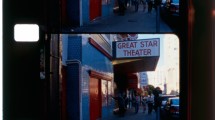Abstract
Set against the historical backdrop of the Chilean Referendum of 1988, Pablo Larraín’s No (2012) presents a fictional account of the television campaign that sought to depose General Pinochet. Larraín structures the film around archive images taken from the “Yes” and “No” campaigns, which make up roughly a third of the film, and fictional sequences shot with the same audiovisual technology from the eighties: U-Matic video and Tube cameras. With this singular formal composition, No invites us to consider how the historicity of its footage—new images shot with old technology, archive images recuperated by digital means—interacts with the ongoing history of the moment it represents. While the film seems to comment on the continuity between the dictatorial past and the democratic regime that replaced it, echoing a position held by sociologists and cultural critics, Larraín’s wish to seamlessly integrate documentary and fiction, effectively erasing the temporal difference of the archive images, also seems to contribute to a sense of historical stasis. We explore these questions through contextual readings of how artists and activists conceived of media technologies, and especially video and photography, in the Eighties, and of how Larraín evaluates digital and analog audiovisual formats, as well as through analyses of the film’s narrative, casting, and audiovisual aesthetics.
The original version of this chapter was revised: Author name has been corrected. The erratum to this chapter is available at https://doi.org/10.1007/978-3-319-76807-6_15
Access this chapter
Tax calculation will be finalised at checkout
Purchases are for personal use only
Similar content being viewed by others
Works Cited
Benson-Allott, Caetlin. “An Illusion Appropriate to the Conditions.” Film Quarterly 66, no. 3 (2013): 61–63.
Barraza Toledo, Vania. “Reviewing the Present in Pablo Larraín’s Historical Cinema.” Iberoamericana XIII, no. 51 (2013): 159–172.
Colectivo Acciones de Arte (CADA). “La función del video.” In CADA día: la creación de un arte social, edited by Robert Neustadt. Santiago: Cuarto Propio, 2001.
Cronovich, Paula T. “‘No’ and No. The Campaign of 1988 and Pablo Larraín’s Film.” Radical History Review 124 (2016): 165–176.
Delgado, Teresa. No+ Pinochet. Documentación, publicidad y ficción en torno al plebiscito chileno de 1988. Berlin: Jakob Kirchheim Verlag, 2013.
Doane, Mary Ann. “The Indexical and the Concept of Media Specificity.” Differences 18, no. 1 (2007): 128–152.
Doane, Mary Ann. “Indexicality: Trace and Sign.” Differences 18, no. 1 (2007): 1–6.
Dzero, Irina. “Larraín’s Film No and Its Inspiration, El plebiscito: Chile’s Transition to Democracy as a Simulacrum.” Confluencia 31, no. 1 (2015): 120–132.
Fornazzari, Alessandro. Speculative Fictions. Chilean Culture, Economics, and the Neoliberal Transition. Pittsburgh: University of Pittsburgh Press, 2013.
Howe, Alexis. “Yes, No, or Maybe?: Transitions in Chilean Society in Pablo Larraín’s No.” Hispania 98, no. 3 (2015): 421–430.
Hartog, François. Régimes d’historicité. Présentisme et expériences du temps. Paris: Éditions du Seuil, 2003.
Hazanavicius, Michel. The Artist. La Petite Reine/ARP Sélection, 2011.
Jung, Berenike. “Imagining the Past. The Politics of Corporeality in Pablo Larraín’s Dictatorship Trilogy.” Paper presented at the workshop, De l’Unité populaire à la transition démocratique: représentations, diffusions, mémoires cinématographiques du Chili, 1970–2013, October 9–10, 2013.
Kay, Ronald. Del espacio de acá. Señales para una mirada americana. Santiago: Editores asociados, 1980.
Kay, Ronald. “On photography Time Split in Two.” ARTMargins 2, no. 3 (2013): 114–122.
Larraín, Pablo. Post Mortem. Santiago (Chile): Fábula, 2009.
Larraín, Pablo. Tony Manero. Santiago (Chile): Fábula, 2009.
Larraín, Pablo. No. Santiago (Chile): Fábula, 2012.
Larraín, Pablo. Neruda. Santiago (Chile): Fábula, 2016.
Liñero Arend, Germán. Apuntes para una historia del video en Chile. Santiago: Ocho Libros Editores, 2010.
Neustadt, Robert. CADA día: la creación de un arte social. Santiago: Cuarto Propio, 2001.
Niemeyer, Katharina, ed. Media and Nostalgia. Yearning for the Past, Present and Future. New York: Palgrave Macmillan, 2014.
Poblete, Juan. “The Memory of the National and the National as Memory.” Latin American Perspectives 42, no. 3 (2015): 92–106.
Richard, Nelly. “El drama y sus tramas.” In Espacio urbano, comunicación y violencia en América Latina, edited by Mabel Moraña, 195–202. Pittsburgh: Instituto Internacional de Literatura Iberoamericana, 2002.
Richard, Nelly. Cultural Residues: Chile in Transition. Minneapolis: University of Minnesota Press, 2004.
Rodowick, David N. The Virtual Life of Film. Cambridge, MA: Harvard University Press, 2007.
Romney, Jonathan. “The Future Is No.” Sight and Sound 23, no. 3 (March 2013): 28–30, 32.
Schaeffer, Jean-Marie. L’image précaire: du dispositif photographique. Paris: Éditions du seuil, 1987.
Thayer, Willy. La crisis no moderna de la universidad moderna. Santiago: Cuarto Propio, 1996.
Urrutia, Carolina. “Campo contra campo. El cine de Cristián Sánchez y de Pablo Larraín.” laFuga 15 (2013). Accessed February 20, 2016. http://www.lafuga.cl/campo-contra-campo/636.
Zemeckis, Robert. Forrest Gump. Los Angeles , USA: Paramount, 1994.
Author information
Authors and Affiliations
Editor information
Editors and Affiliations
Rights and permissions
Copyright information
© 2018 The Author(s)
About this chapter
Cite this chapter
Cisneros, J. (2018). Precarious Images: Media and Historicity in Pablo Larraín’s No. In: Burucúa, C., Sitnisky, C. (eds) The Precarious in the Cinemas of the Americas. Global Cinema. Palgrave Macmillan, Cham. https://doi.org/10.1007/978-3-319-76807-6_3
Download citation
DOI: https://doi.org/10.1007/978-3-319-76807-6_3
Published:
Publisher Name: Palgrave Macmillan, Cham
Print ISBN: 978-3-319-76806-9
Online ISBN: 978-3-319-76807-6
eBook Packages: Literature, Cultural and Media StudiesLiterature, Cultural and Media Studies (R0)




